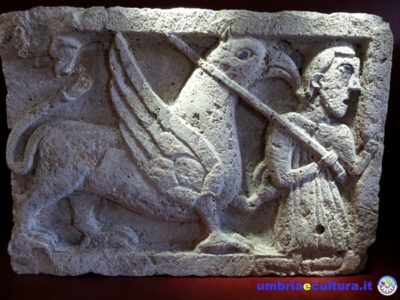In the historical center of Narni, the fabulous Narnia, one of the richest of Umbria, for atmosphere and ancient buildings, stands Eroli Palace, in whose rooms the Museum of the city and the territory is housed.
Narni was first Umbrian then Roman, the famous Narnia, its name derives from Naar = river: the Nera river flows at the bottom of the rocky ridge where the city stands.
… But few know that the ancient Egyptians came to Narni!!!
Despite them, and thousands of years later, a III century wooden sarcophagus B.C. belonged to a priest named Ramose and the mummy of a Nubian girl became Narni “cityzens”. A wealthy inhabitant of Narni bought them at the end of the nineteenth century during his trip in Egypt, to host them in the living room of his home.
Some news about the Nubian girl: she died at about twenty years of tapeworm infection, her mummy, very well preserved, is decorated with the technique of cartonage: the funeral mask is remarkable and the description of the feet with flip-flops is very poetic.
In the rooms on the main floor, with valuable coffered ceilings, the finds from Narni area follow one another, starting with a pair of fangs of a mammoth ancestor, through a series of finds from the prehistoric age and funerary furnishings. To be noted the trompe l’oeil on the wall that houses the window: the view on the opposite hill continues beyond the window jambs on the walls on the sides, and offers a dreamy vision, partly real and partly virtual, of the hill of Santa Croce.
Roman Narnia boasts an emperor: Marco Cocceio Nerva, in one of the rooms it is possible to see a plate dedicated to him. But particularly tender is the slab dedicated by the son to the mother, who was an obstetrician, while the inscription, at the time placed above a tomb and almost certainly made by a relative of the deceased, is very curious. invites us not to dirty the grave with political slogans or anything else (rudeness, therefore, has ancient roots …)
A jump in the Middle Ages with two bas-reliefs of a now disappeared church with the griffin of Narni and the original bronze cup of the fountain in Piazza dei Priori, built in 1303 by Marcuccio da Todi and Giovanni di Marco.
In art gallery a wooden statue of the Sedes Sapientiae (seated Madonna and Child), detached frescoes of remarkable workmanship and the suggestive room dedicated to the breathtaking Ghirlandaio Altarpiece.
The setting takes your breath away, in a totally black environment the fifteenth-century masterfully illuminated work stands out, the radiance of gold applied conveys the power and grandeur of the scene.
Commissioned by Cardinal Berardo Eroli, the wooden altarpiece represents the scene of the coronation of the Virgin. Arrived from Florence after the death of the client, who never saw it completed, it was placed in the apse of the church of San Girolamo. This arrangement was by no means accidental, during some days of the year the rays of light, filtering through the rose window, hit exactly the central scene of Christ crowning the Virgin, creating a further, magical suggestion.
The lighting layout reproduces this particular atmosphere, allowing the viewer to understand and enjoy the great scenographic effect.
Please notice, in the center of the main scene, a raised hemisphere (unusual), perhaps requested by the client, in order to obtain a further glare of light. even Steve McCurry has not been able to recreate the atmosphere that reigns in its presence, no picture can reproduce the magnificence of this masterpiece, all that remains is to come to discover it.
In front of the large altarpiece an Annunciation by Benozzo Gozzoli, not one of the most successful works, some afterthoughts of the artist are very visible, but of sure impact for the delicacy of the faces and the curious, precious details; from the decoration of the carpet depicting dogs (perhaps the work was commissioned by the Dominicans Domini Canes?), to the decoration of the bedspread on the bed of the Virgin with mistletoe branches, symbol of the Passion of Christ, to the keys inserted in a drawer, one of which dangles casting its shadow.
Walking through Narni really allows you to breathe an atmosphere outside of time, there are countless ideas for visits, such as Narni Sotterranea. The visit to the Eroli Museum is an indispensable complement, the scenography of the Pala del Ghirlandaio and the delicacy of Benozzo Gozzoli are worth the trip and the visit.
Benedetta Tintillini
Find Eroli Museum in Narni on Google Maps:



